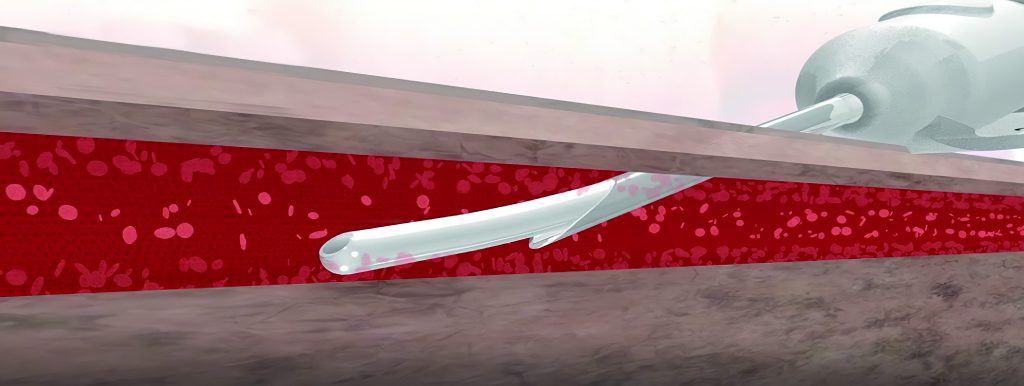Innovative startup reshaping the Peripheral Intravenous Catheter (PIV) market closes seed financing round of $2.5M.
DELRAY BEACH, Florida (October 27, 2020) – SkyDance Vascular (SkyDance) today announced the completion of their initial seed funding round, securing $2.5M through private investments.
The startup, founded in 2017, has reimagined the Peripheral Intravenous Catheter (PIV) designed to reduce the number of known complications associated with the traditional PIV’s. The new patent-pending solution places the catheter through the needle such that the catheter is protected from contacting the skin lowering the risk of contamination. The unique bevel-only access is expected to simplify the PIV procedure and improve procedural success. The proprietary contoured, directional flow catheter is designed to reduce the potential risk of phlebitis and infiltration by delivering infusions more efficiently. And finally, the passive needle retraction feature will offer unprecedented sharps safety.
“We appreciate the support of our investors as we look to grow the company and deliver a suite of safe products to both the patient and healthcare workers,” said Michael Anstett, Founder of SkyDance. “We intend to disrupt a very mature medical device market by offering exceptional performance from a PIV that is notably easy to use and remarkably safe.”
The completion of this financing builds on an extraordinary year for SkyDance which saw strong executive appointments, endorsement by multiple key opinion leaders, a freeze of the product design, and the development of the protocols for both the company’s clinical trials and FDA submission.
Russell S. Nassof, JD, a leading consultant in the field of environmental and health risks for over 25 years, said “SkyDance’s Osprey solution is well-timed given the rapidly increasing demand for solutions that concentrate on infection control.” Nassof continued with “The Osprey Vascular Access Catheter appears to be a viable technology improvement that can have a significant impact upon the prevention of adverse events and may result in changing the standard of care and improving patient outcomes.”
The MedFocus Funds is a prominent investor in the healthcare field guiding six past startups to become public companies and twelve companies to exit via acquisition and has placed a large investment into SkyDance. Michael R. Henson of the MedFocus Funds said “We’re excited to be a significant part of this seed round for SkyDance. We have been impressed by what the team has accomplished in a short period of time and look forward to supporting their vision to produce safer healthcare solutions. This is another example of our focus on investing in the leading companies across healthcare markets.”
Bill Bold, SkyDance’s CEO announced “We’re really excited about what the next 18 – 24 months holds for SkyDance. This latest round of financing demonstrates that the investment community recognizes the value of SkyDance, our executive team, and the potential of disrupting this market.”
SkyDance will use the new funds for general working capital to complete the FDA clearance process and ready itself for commercialization in the first part of 2021.
About SkyDance Vascular
SkyDance Vascular, founded in 2017, is working to redesign the Peripheral Intravenous Catheter (PIV). Its new family of products, the Osprey catheter delivery system, will be launched in early 2021 and is expected to provide a positive impact on PIV outcomes by utilizing uniquely designed features such as Skin Avoidance Technology, Contoured Directional Flow Tipping, and Passive Needle Retraction. Its goal is to deliver greater first-attempt success and lower complication rates, improved dwell times, greater completion of therapy rates, and increased patient satisfaction. The company has assembled an executive leadership group comprised of individuals with decades of executive, clinical, regulatory, and engineering experience, and who together have successfully built other companies in the vascular access space. For more information, visit https://www.skydancevascular.comor contact Bill Bold at bill.bold@skydancevascular.com. LinkedIn: https://www.linkedin.com/company/40779227.
About Russel S. Nassof
Mr. Nassof is an attorney who has been involved in the fields of health risk consulting and clinician education for over 20 years concentrating his work in the areas of infection prevention, and risk/liability minimization for healthcare and environmental risk. He has presented hundreds of seminars and webinars to legal, insurance, loss control, healthcare, and risk management groups throughout the United States, Canada, Europe, and Asia. Mr. Nassof has been involved as a consulting/testifying expert on such diverse events as recent outbreaks of Legionnaires’ Disease, Middle East Respiratory Syndrome (MERS), and Ebola, his passion is focused on managing risk and liability for vascular catheter-associated risk and was the first non-clinician elected to the AVA Board of Directors and also served as a reviewer on the 2016 INS Standards. He has coauthored books on environmental/healthcare issues, holds a patent on a fungal sensing device and recently developed a peripheral catheter matrix addressing clinician best practice issues and liability minimization. Mr. Nassof received his Juris Doctorate and undergraduate degrees from Emory University in Atlanta and currently serves as the AVA National Treasurer.
About the MedFocus Funds
The Medfocus Funds primary mission is to serve as a Founder of early-stage medical technology startups and continue to invest in and provide management guidance and assistance to these companies as they mature. In addition, via a network of both physicians and medical technology industry experts, the Medfocus Funds also seeks to uncover and invest at an early stage innovative medical technology firms which provide increased technological advantage, improved clinical value and lower patient costs. The Medfocus Funds have close working relationships with large venture capital and private equity firms to assist in financially supporting these firms as they require additional capital to obtain regulatory approvals and achieve commercial success.
Contact Information
Bill Bold
SkyDance Vascular
https://skydancevascular.com/
561-573-5360
David Moss
Thasis LLC
http://www.thasis.com
908-200-1391










